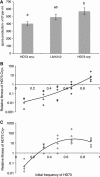Division of labour and terminal differentiation in a novel Bacillus thuringiensis strain
- PMID: 25083932
- PMCID: PMC4303623
- DOI: 10.1038/ismej.2014.122
Division of labour and terminal differentiation in a novel Bacillus thuringiensis strain
Abstract
A major challenge in bacterial developmental biology has been to understand the mechanisms underlying cell fate decisions. Some differentiated cell types display cooperative behaviour. Cooperation is one of the greatest mysteries of evolutionary biology and microbes have been considered as an excellent system for experimentally testing evolution theories. Bacillus thuringiensis (Bt) is a spore-forming bacterium, which is genetically closely related to B. anthracis, the agent of anthrax, and to B. cereus, an opportunistic human pathogen. The defining feature that distinguishes Bt from its relatives is its ability to produce crystal inclusions in the sporulating cells. These toxins are solubilized after ingestion and are cooperative public goods in insect hosts. In this study, we describe a Bt strain LM1212 that presents the unique ability to terminally differentiate into crystal producers and spore formers. Transcriptional analysis based on lacZ and gfp reporter genes suggested that this phenotype is the consequence of a new type of cell differentiation associated with a novel regulation mode of cry gene expression. The differentiating crystal-producer phenotype has higher spore productivity than a typical Bt strain and is better able to compete with Cry toxin null 'cheaters'. Potentially, this division of labour provides additional fitness benefits in terms of spore viability or durability of Cry toxin.
Figures





References
-
- Agaisse H, Lereclus D. Structural and functional analysis of the promoter region involved in full expression of the cryIIIA toxin gene of Bacillus thuringiensis. Mol Microbiol. 1994;13:97–107. - PubMed
-
- Agaisse H, Lereclus D. STAB-SD: a Shine-Dalgarno sequence in the 5′ untranslated region is a determinant of mRNA stability. Mol Microbiol. 1996;20:633–643. - PubMed
-
- Bell G.1985The origin and early evolution of germ cells as illustrated by the VolvocalesIn: Halvorson H, Mornoy A (eds)The Origin and Evolution of Sex Alan R. Liss: New York, NY, USA; 221–256.
Publication types
MeSH terms
Substances
LinkOut - more resources
Full Text Sources
Other Literature Sources

